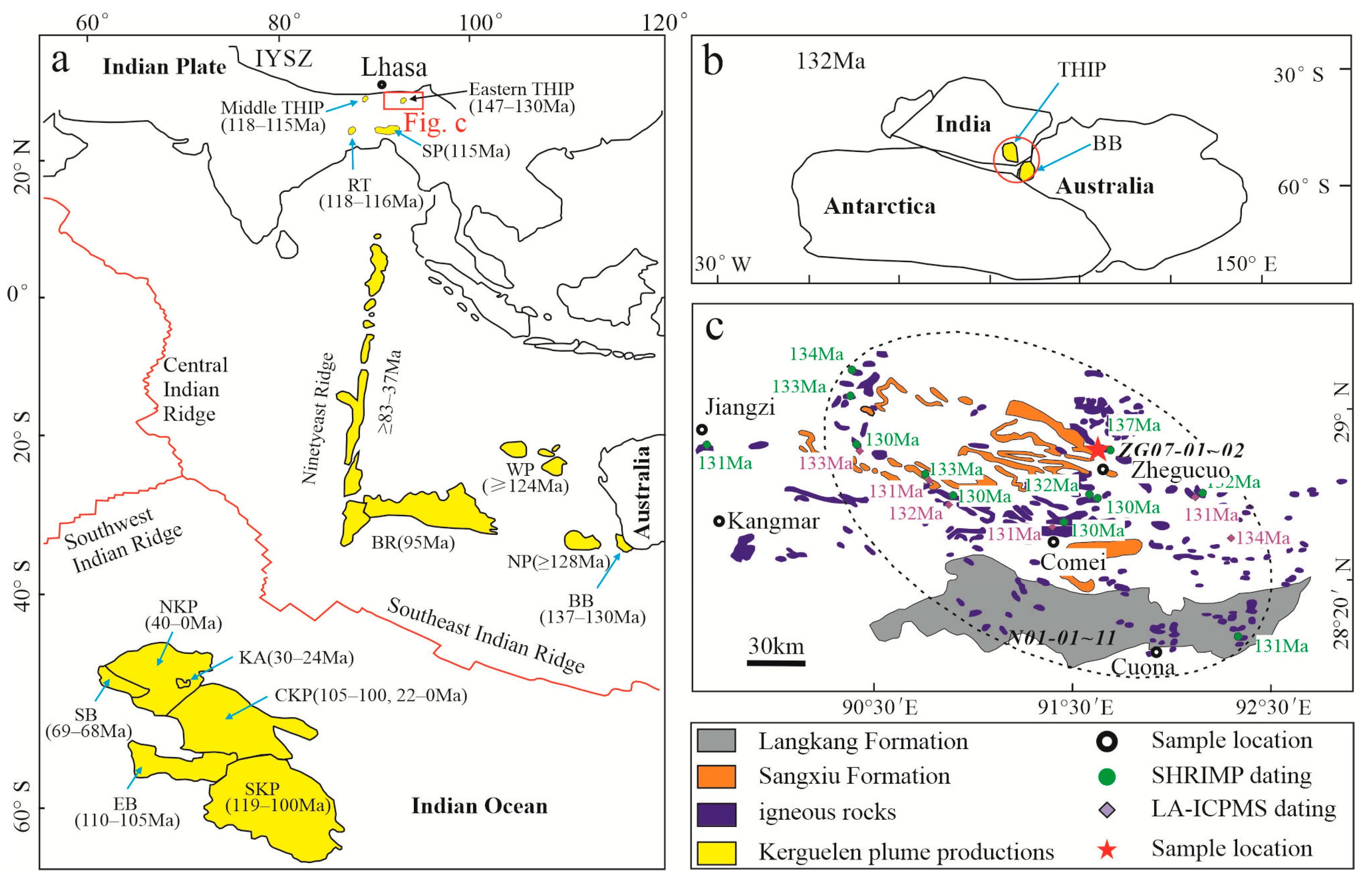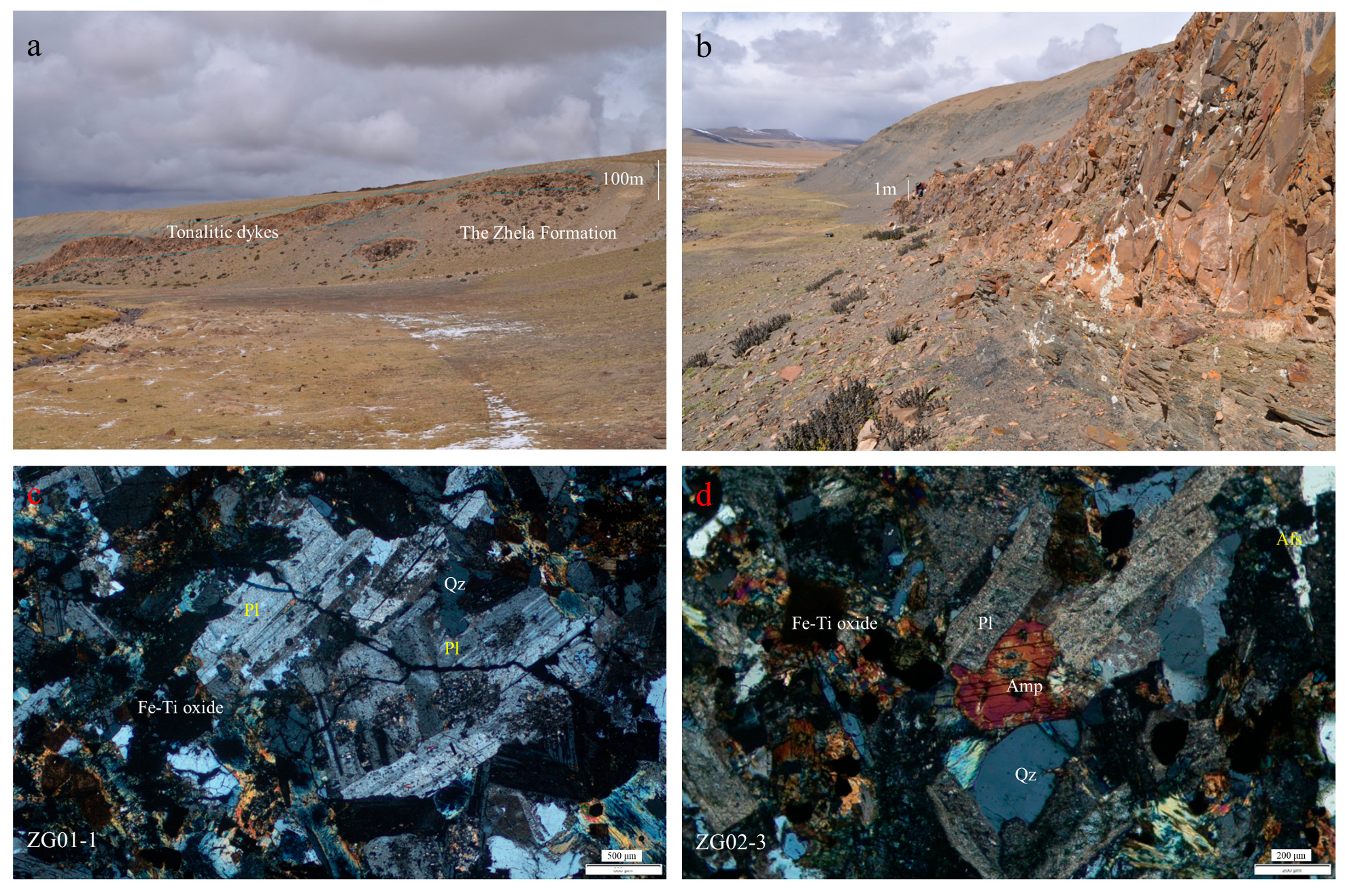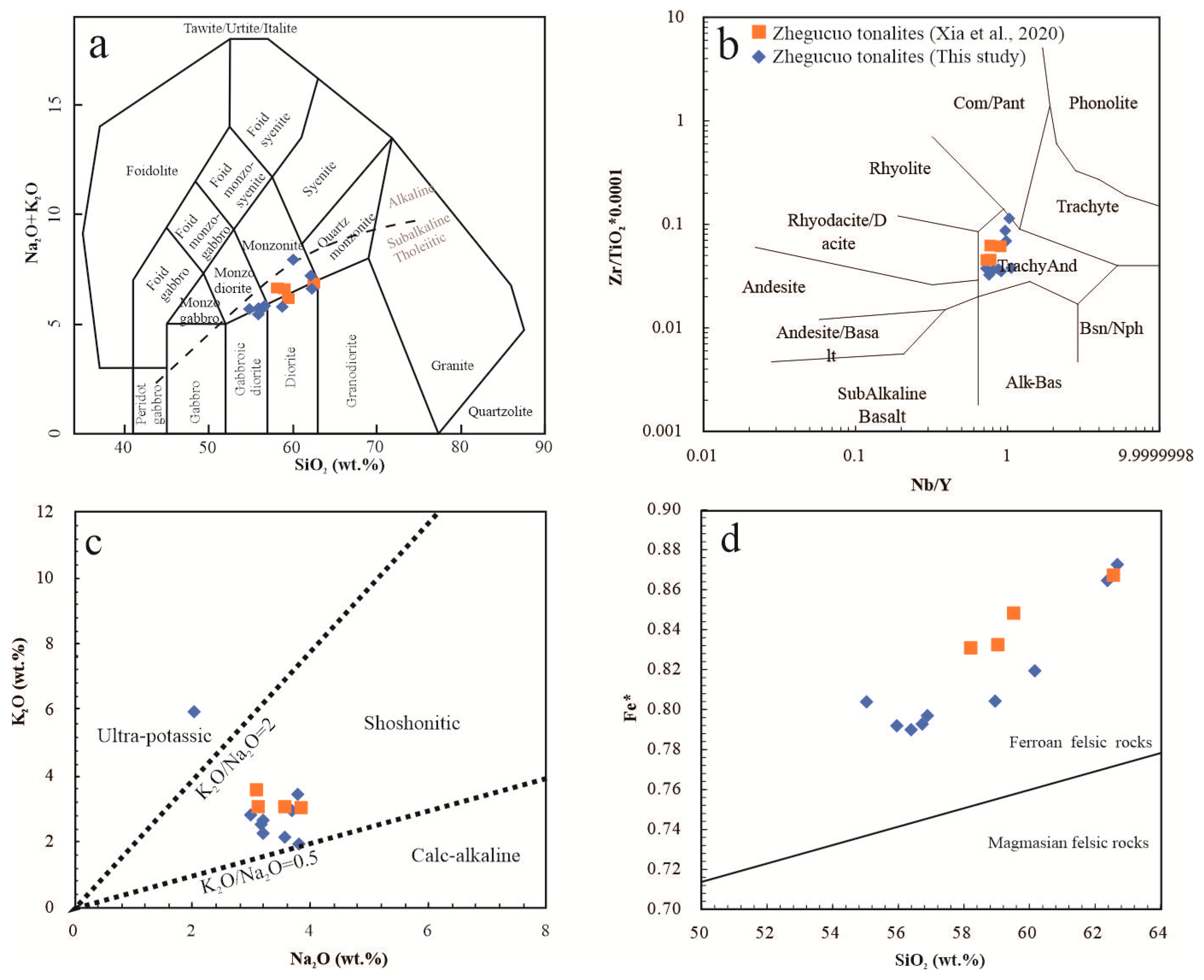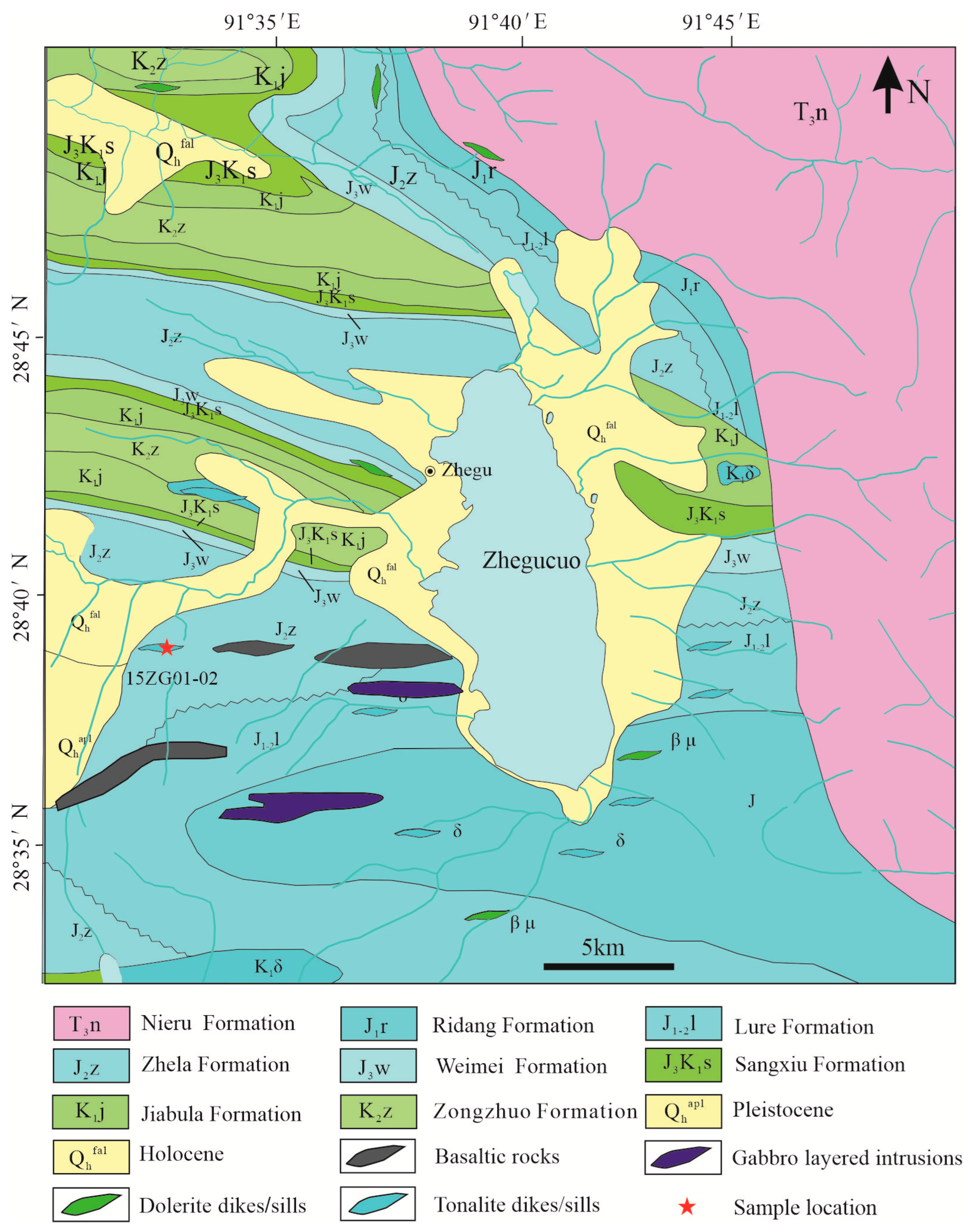Petrogenesis of Intermediate Rocks in Tethyan Himalaya Igneous Province (SE Tibet): The Role of Source Composition and Fractional Crystallization
Abstract
1. Introduction
2. Geological Setting
3. Analytical Methods
3.1. Zircon U-Pb Analysis
3.2. Whole-Rock Geochemical Analysis
3.3. Nd Isotope Analysis
4. Results
4.1. Petrography
4.2. Zircon U–Pb Ages
4.3. Major- and Trace-Element Geochemistry
5. Discussion
5.1. Fractional Crystallization and Crustal Assimilation
5.2. Petrogenesis of the Zhegucuo Tonalites
5.3. Mantle Sources
5.4. Implications for Intermediate Magmatism in the LIPs
6. Conclusions
- The zircon U-Pb weighted mean age of the Zhegucuo tonalites is 130.81 ± 0.55 Ma, indicating that they were products of Early Cretaceous magmatism.
- The rocks exhibit low Mg# values and low concentrations of Cr and Ni, indicating that the parental magma underwent significant fractional crystallization. The homogeneous εNd(t) values (−0.34 to +0.01), which are distinctly different from those of the regional crust (εNd(t) = −12 to −13), demonstrate that the magmas experienced negligible crustal contamination during their ascent and differentiation.
- Based on field relationships, geochemistry, and isotopic evidence, the Zhegucuo tonalites are most plausibly explained as residual liquids derived from extensive fractional crystallization of a basaltic parental magma originating from an enriched lithospheric mantle source.
- Based on FC3MS and FCKANTMS systematics, the mantle source of the Zhegucuo mafic rocks likely contains a peridotitic component, and extensive fractional crystallization of evolved magmas accounts for the exceptionally high FC3MS and FCKANTMS values in our samples.
Supplementary Materials
Author Contributions
Funding
Data Availability Statement
Conflicts of Interest
References
- Frey, F.A.; Weis, D.; Yang, H.J.; Nicolaysen, K.; Leyrit, H.; Giret, A. Temporal geochemical trends in Kerguelen Archipelago basalts: Evidence for decreasing magma supply from the Kerguelen plume. Chem. Geol. 2000, 164, 61–80. [Google Scholar] [CrossRef]
- Coffin, M.F.; Pringle, M.S.; Duncan, R.A.; Gladczenko, T.P.; Storey, M.; Müller, R.D.; Gahagan, L.A. Kerguelen hotspot magma output since 130 Ma. J. Petrol. 2002, 43, 1121–1139. [Google Scholar] [CrossRef]
- Storey, M.; Saunders, A.D.; Tarney, J.; Gibson, I.L.; Norry, M.J.; Thirlwall, M.F.; Leat, P.; Thompson, R.N.; Menzies, M.A. Contamination of Indian Ocean asthenosphere by the Kerguelen-Heard mantle plume. Nature 1989, 338, 574–576. [Google Scholar] [CrossRef]
- Zhu, D.C.; Chung, S.L.; Mo, X.X.; Zhao, Z.D.; Niu, Y.; Song, B.; Yang, Y.H. The 132 Ma Comei-Bunbury large igneous province: Remnants identified in present-day southeastern Tibet and southwestern Australia. Geology 2009, 37, 583–586. [Google Scholar] [CrossRef]
- Chen, S.S.; Fan, W.M.; Shi, R.D.; Liu, X.H.; Zhou, X.J. 118–115 Ma magmatism in the Tethyan Himalaya igneous province: Constraints on Early Cretaceous rifting of the northern margin of Greater India. Earth Planet. Sci. Lett. 2018, 491, 21–33. [Google Scholar] [CrossRef]
- Chen, S.S.; Fan, W.M.; Shi, R.D.; Xu, J.F.; Liu, Y.M. The Tethyan Himalaya Igneous Province: Early Melting Products of the Kerguelen Mantle Plume. J. Petrol. 2021, 62, egab069. [Google Scholar] [CrossRef]
- Kent, R.W.; Saunders, A.D.; Kempton, P.D.; Ghose, N.C. Rajmahal Basalts, Eastern India: Mantle sources and melt distribution at a volcanic rifted margin. In Large Igneous Provinces: Continental, Oceanic and Planetary Volcanism; Mahoney, J.J., Coffin, M.F., Eds.; American Geophysical Union: Washington, DC, USA, 1997; Volume 100, pp. 145–182. [Google Scholar]
- Olierook, H.K.; Jourdan, F.; Merle, R.E.; Timms, N.E.; Kusznir, N.; Muhling, J.R. Bunbury Basalt: Gondwana breakup products or earliest vestiges of the Kerguelen mantle plume? Earth Planet. Sci. Lett. 2016, 440, 20–32. [Google Scholar] [CrossRef]
- Wang, Y.Y.; Zeng, L.S.; Gao, L.E.; Yan, L.L.; Zhao, L.H.; Gao, J.H.; Di, Y.L.; Li, G.X.; Tian, Y.H. Plume-lithosphere interaction in the Comei Large Igneous Province: Evidence from two types of mafic dykes in Gyangze, south Tibet, China. China Geol. 2024, 7, 80–90. [Google Scholar] [CrossRef]
- Zhu, D.C.; Mo, X.X.; Zhao, Z.D.; Niu, Y.; Chung, S.L. Whole-rock elemental and zircon Hf isotopic geochemistry of mafic and ultramafic rocks from the Early Cretaceous Comei large igneous province in SE Tibet: Constraints on mantle source characteristics and petrogenesis. Himal. J. Sci. 2008, 5, 178–180. [Google Scholar] [CrossRef]
- Zhu, D.C.; Mo, X.X.; Pan, G.T.; Zhao, Z.D.; Dong, G.C.; Shi, Y.R.; Liao, Z.L.; Wang, L.Q.; Zhou, C.Y. Petrogenesis of the earliest Early Cretaceous mafic rocks from the Cona area of the eastern Tethyan Himalaya in south Tibet: Interaction between the incubating Kerguelen plume and the eastern Greater India lithosphere? Lithos 2008, 100, 147–173. [Google Scholar] [CrossRef]
- Zhu, D.; Pan, G.; Mo, X.; Wang, L.; Liao, Z.; Jiang, X.; Geng, Q. SHRIMP U-Pb zircon dating for the dacite of the Sangxiu Formation in the central segment of Tethyan Himalaya and its implications. Chin. Sci. Bull. 2005, 50, 563–568. [Google Scholar] [CrossRef]
- Zhu, D.; Pan, G.; Mo, X.; Liao, Z.; Jiang, X.; Wang, L.; Zhao, Z. Petrogenesis of volcanic rocks in the Sangxiu Formation, central segment of Tethyan Himalaya: A probable example of plume–lithosphere interaction. J. Asian Earth Sci. 2007, 29, 320–335. [Google Scholar] [CrossRef]
- Tong, J.S.; Liu, J.; Zhong, H.M.; Xia, J.; Lu, R.K.; Li, Y.H. Zircon U-Pb dating and geochemistry of mafic dike swarms in the Lhozag area, southern Tibet, China, and their tectonic implications. Geol. Bull. China 2007, 26, 1654–1664. [Google Scholar]
- Hu, X.; Jansa, L.; Chen, L.; Griffin, W.L.; O’Reilly, S.Y.; Wang, J. Provenance of Lower Cretaceous Wölong Volcaniclastics in the Tibetan Tethyan Himalaya: Implications for the final breakup of Eastern Gondwana. Sediment. Geol. 2010, 223, 193–205. [Google Scholar] [CrossRef]
- Liu, Z.; Zhou, Q.; Lai, Y.; Qing, C.; Li, Y.; Wu, J.; Xia, X.B. Petrogenesis of the Early Cretaceous Laguila bimodal intrusive rocks from the Tethyan Himalaya: Implications for the break-up of Eastern Gondwana. Lithos 2015, 236–237, 190–202. [Google Scholar] [CrossRef]
- Olierook, H.K.H.; Jiang, Q.; Jourdan, F.; Chiaradia, M. Greater Kerguelen large igneous province reveals no role for Kerguelen mantle plume in the continental breakup of eastern Gondwana. Earth Planet. Sci. Lett. 2019, 511, 244–255. [Google Scholar] [CrossRef]
- Olierook, H.K.H.; Merle, R.E.; Jourdan, F. Toward a Greater Kerguelen large igneous province: Evolving mantle source contributions in and around the Indian Ocean. Lithos 2017, 282, 163–172. [Google Scholar] [CrossRef]
- Zeng, Y.C.; Xu, J.F.; Chen, J.L.; Wang, B.D.; Huang, F.; Yu, H.X.; Chen, X.F.; Zhao, P.P. Breakup of eastern Gondwana as inferred from the lower cretaceous charong dolerites in the central Tethyan Himalaya, southern Tibet. Palaeogeogr. Palaeoclimatol. Palaeoecol. 2019, 515, 70–82. [Google Scholar] [CrossRef]
- Zhou, Q.; Liu, Z.; Lai, Y.; Wang, G.; Liao, Z.; Li, Y.; Wu, J.; Wang, S.; Qing, C. Petrogenesis of mafic and felsic rocks from the Comei large igneous province, South Tibet: Implications for the initial activity of the Kerguelen plume. Geol. Soc. Am. Bull. 2018, 130, 811–824. [Google Scholar] [CrossRef]
- Li, Y.; Ding, F.; Yang, L.; Xie, X.; Xu, K.; Li, Q.; Yu, W.; Sun, Y. Geochemical characteristics and geological significance of basalts in the Sangxiu formation, Rongbu area, southern Tibet. Arab. J. Geosci. 2019, 12, 757. [Google Scholar] [CrossRef]
- Wang, Y.; Zeng, L.; Asimow, P.D.; Gao, L.E.; Ma, C.; Antoshechkina, P.M.; Guo, C.L.; Hou, K.J.; Tang, S.H. Early Cretaceous high-Ti and low-Ti mafic magmatism in Southeastern Tibet: Insights into magmatic evolution of the Comei Large Igneous Province. Lithos 2018, 296–299, 396–411. [Google Scholar] [CrossRef]
- Wang, Y.; Zeng, L.; Hou, K.; Gao, L.E.; Wang, Q.; Zhao, L.; Gao, J.; Li, G. Mantle Source Components and Magmatic Evolution for the Comei Large Igneous Province: Evidence from the Early Cretaceous Niangzhong Mafic Magmatism in Tethyan Himalaya. J. Earth Sci. 2022, 33, 133–149. [Google Scholar] [CrossRef]
- Meng, F.; Meng, Y.; Wei, Y. Identification of the EMII-type mantle end-member of the Kerguelen mantle plume and its implications for the initial breakup of eastern Gondwana: New constraints from the Cretaceous diabase in the Tethyan Himalaya. J. Asian Earth Sci. 2024, 272, 106250. [Google Scholar] [CrossRef]
- Wang, Y.N.; Chen, S.S. Early Cretaceous mafic rocks in the Tethyan Himalaya igneous province, Tibet: Implications for the eastern Gondwana breakup. J. Asian Earth Sci. 2024, 264, 106066. [Google Scholar] [CrossRef]
- Cheng, M.; Lou, Y.; Min, Y.; Tang, Y.; Li, X.; Zhang, M.; Hu, X.M.; Wan, T.Y.; Zou, H.; Xu, K.H.; et al. Geochronology and geochemistry of mafic igneous rocks in the Zhegu area of southern Tibet. Front. Earth Sci. 2025, 13, 1513583. [Google Scholar] [CrossRef]
- Xia, Y.; Wang, Q.; Zhu, D.C.; Ernst, R.E.; Zhang, S.; Liu, D.; Zhao, Z.D. Intermediate rocks in the Comei large igneous provinces produced by amphibole crystallization of tholeiitic basaltic magma. Lithos 2020, 374, 105731. [Google Scholar] [CrossRef]
- Yin, A.; Harrison, T.M. Geologic evolution of the Himalayan-Tibetan orogen. Annu. Rev. Earth Planet. Sci. 2000, 28, 211–280. [Google Scholar] [CrossRef]
- Roy, S.S. A possible Himalayan microcontinent. Nature 1976, 263, 117–120. [Google Scholar] [CrossRef]
- Liu, X.; Hsu, K.J.; Ju, Y.; Li, G.; Liu, X.; Wei, L.; Zhou, X.J.; Zhang, X. New interpretation of tectonic model in south Tibet. J. Asian Earth Sci. 2012, 56, 147–159. [Google Scholar] [CrossRef]
- Xiao, W.; Ao, S.; Yang, L.; Han, C.; Wan, B.; Zhang, J.E.; Zhang, Z.Y.; Li, R.; Chen, Z.Y.; Song, S. Anatomy of composition and nature of plate convergence: Insights for alternative thoughts for terminal India–Eurasia collision. Sci. China Earth Sci. 2017, 60, 1015–1039. [Google Scholar] [CrossRef]
- Bian, W.W.; Yang, T.S.; Ma, Y.M.; Jin, J.J.; Gao, F.; Wang, S.; Peng, W.X.; Zhang, S.H.; Wu, H.C.; Li, H.Y.; et al. Paleomagnetic and geochronological results from the Zhela and Weimei Formations lava flows of the eastern Tethyan Himalaya: New insights into the breakup of eastern Gondwana. J. Geophys. Res. Solid Earth 2019, 124, 44–64. [Google Scholar] [CrossRef]
- Peng, W.X.; Yang, T.S.; Shi, Y.R.; Bian, W.W.; Ma, Y.M.; Wang, S.; Jiao, X.W.; Ma, J.H.; Kang, Y.L.; Zhang, S.H.; et al. Role of the Kerguelen mantle plume in breakup of eastern Gondwana: Evidence from early cretaceous volcanic rocks in the eastern Tethyan Himalaya. Palaeogeogr. Palaeoclimatol. Palaeoecol. 2022, 588, 110823. [Google Scholar] [CrossRef]
- Ma, Y.M.; Yang, T.S.; Bian, W.W.; Jin, J.J.; Zhang, S.H.; Wu, H.C.; Li, H.Y. Early Cretaceous paleomagnetic and geochronologic results from the Tethyan Himalaya: Insights into the Neotethyan paleogeography and the India-Asia collision. Sci. Rep. 2016, 6, 21605. [Google Scholar] [CrossRef]
- Wu, F.; Wang, L.; Huo, Z.; Liao, J.; Tang, Y.; Yang, T.; Li, X.; Wang, S.J.; Xiao, H.J.; Cao, B.H. Geochronology and geochemistry of the Late Jurassic-Early Cretaceous Sangxiu Formation volcanic rocks of the Chegu region, Southern Tibet. Front. Earth Sci. 2023, 11, 1171090. [Google Scholar] [CrossRef]
- Shi, Y.; Hou, C.; Anderson, J.L.; Yang, T.; Ma, Y.; Bian, W. Zircon SHRIMP U–Pb age of Late Jurassic OIB-type volcanic rocks from the Tethyan Himalaya: Constraints on the initial activity time of the Kerguelen mantle plume. Acta Geochim. 2017, 37, 441–455. [Google Scholar] [CrossRef]
- Liang, J.; Bian, W.; Jiao, X.; Peng, W.; Ma, J.; Wang, S.; Ma, Y.; Zhang, S.; Wu, H.; Li, H.; et al. Geochronological results from the Zhela Formation volcanics of the Tethyan Himalaya and their implications for the breakup of eastern Gondwana. Sci. Rep. 2023, 13, 20035. [Google Scholar] [CrossRef] [PubMed]
- Jiao, X.W.; Shi, Y.R.; Yang, T.S.; Bian, W.W.; Wang, S.; Peng, W.X. U-Pb age of detrital zircons from lower Cretaceous in eastern Tethyan Himalaya and its paleogeography. Earth Sci. 2021, 46, 2850–2859. [Google Scholar]
- Sláma, J.; Košler, J.; Condon, D.J.; Crowley, J.L.; Gerdes, A.; Hanchar, J.M.; Horstwood, M.S.; Morris, G.A.; Nasdala, L.; Norberg, N.; et al. Plešovice zircon—A new natural reference material for U–Pb and Hf isotopic microanalysis. Chem. Geol. 2008, 249, 1–35. [Google Scholar] [CrossRef]
- Van Achterbergh, E.; Ryan, C.G.; Jackson, S.E.; Griffin, W.L. Data Reduction Software for LA-ICP-MS. In Laser Ablation-ICP-Mass Spectrometry in the Earth Sciences: Principles and Applications; Sylvester, P.J., Ed.; Mineralogical Association of Canada: Ottawa, ON, Canada, 2001; Short Course Series 29; pp. 239–243. [Google Scholar]
- Anderson, T. Correction of common lead in U–Pb analyses that do not report 204Pb. Chem. Geol. 2002, 192, 59–79. [Google Scholar] [CrossRef]
- Vermeesch, P. IsoplotR: A free and open toolbox for geochronology. Geosci. Front. 2018, 9, 1479–1493. [Google Scholar] [CrossRef]
- Tanaka, T.; Togashi, S.; Kamioka, H.; Amakawa, H.; Kagami, H.; Hamamoto, T.; Yuhara, M.; Orihashi, Y.; Yoneda, S.; Shimizu, H.; et al. JNdi-1: A neodymium isotopic reference in consistency with LaJolla neodymium. Chem. Geol. 2000, 168, 279–281. [Google Scholar] [CrossRef]
- Hoskin, P.W.; Schaltegger, U. The composition of zircon and igneous and metamorphic petrogenesis. Rev. Mineral. Geochem. 2003, 53, 27–62. [Google Scholar] [CrossRef]
- Winchester, J.A.; Floyd, P.A. Geochemical discrimination of different magma series and their differentiation products using immobile elements. Chem. Geol. 1977, 20, 325–343. [Google Scholar] [CrossRef]
- Foley, S.F.; Venturelli, G.; Green, D.H.; Toscani, L. The ultrapotassic rocks: Characteristics, classification and constraints for petrogenetic models. Earth Sci. Rev. 1987, 24, 81–134. [Google Scholar] [CrossRef]
- Frost, B.R.; Barnes, C.G.; Collins, W.J.; Arculus, R.J.; Ellis, D.J.; Frost, C.D. A geochemical classification for granitic rocks. J. Petrol. 2001, 42, 2033–2048. [Google Scholar] [CrossRef]
- Sun, S.S.; McDonough, W.F. Chemical and isotopic systematics of oceanic basalts: Implications for mantle composition and processes. In Magmatism in the Ocean Basins; Saunders, A.D., Norry, M.J., Eds.; Geological Society London Special Publications: London, UK, 1989; Volume 42, pp. 313–345. [Google Scholar]
- Drummond, M.S.; Defant, M.J.; Kepezhinskas, P.K. Petrogenesis of slab-derived trondhjemite–tonalite-dacite/adakite magmas. In The Third Hutton Symposium on the Origin of Granites and Related Rocks; Geological Society of America: Boulder, CO, USA, 1996; Volume 315, pp. 205–215. [Google Scholar]
- Yogodzinski, G.M.; Kay, R.W.; Volynets, O.N.; Koloskov, A.V.; Kay, S.M. Magnesian andesite in the western Aleutian Komandorsky region: Implications for slab melting and processes in the mantle wedge. Geol. Soc. Am. Bull. 1995, 107, 505–519. [Google Scholar] [CrossRef]
- Tatsumi, Y. Origin of high-magnesian andesites in the Setouchi volcanic belt, southwest Japan, II. Melting phase relations at high pressures. Earth Planet. Sci. Lett. 1982, 60, 305–317. [Google Scholar] [CrossRef]
- Marschall, H.R.; Schumacher, J.C. Arc magmas sourced from mélange diapirs in subduction zones. Nat. Geosci. 2012, 5, 862–867. [Google Scholar] [CrossRef]
- Straub, S.M.; LaGatta, A.B.; Martin-Del Pozzo, A.L.; Langmuir, C.H. Evidence from high-Ni olivines for a hybridized peridotite/pyroxenite source for orogenic andesites from the central Mexican Volcanic Belt. Geochem. Geophys. Geosystems 2008, 9, Q03007. [Google Scholar] [CrossRef]
- Grove, T.L.; Donnelly-Nolan, J.M.; Housh, T. Magmatic processes that generated the rhyolite of Glass Mountain, Medicine Lake volcano, N California. Contrib. Mineral. Petrol. 1997, 127, 205–223. [Google Scholar] [CrossRef]
- Lustrino, M. How the delamination and detachment of lower crust can influence basaltic magmatism. Earth Sci. Rev. 2005, 72, 21–38. [Google Scholar] [CrossRef]
- Tatsumi, Y.; Sato, T.; Kodaira, S. Evolution of the Earth as an andesite planet: Water, plate tectonics, and delamination of anti-continent. Earth Planet Space 2015, 67, 91. [Google Scholar] [CrossRef]
- Turner, S.; Arnaud, N.; Liu, J.; Rogers, N.; Hawkesworth, C.; Harris, N.; Kelley, S.V.; Van Calsteren, P.; Deng, W. Post-collision, shoshonitic volcanism on the Tibetan Plateau: Implications for convective thinning of the lithosphere and the source of ocean island basalts. J. Petrol. 1996, 37, 45–71. [Google Scholar] [CrossRef]
- Rapp, R.P.; Watson, E.B. Dehydration melting of metabasalt at 8–32 kbar: Implications for continental growth and crust-mantle recycling. J. Petrol. 1995, 36, 891–931. [Google Scholar] [CrossRef]
- Cao, H.W.; Pei, Q.M.; Santosh, M.; Li, G.M.; Zhang, L.K.; Zhang, X.F.; Zhang, Y.H.; Zou, H.; Dai, Z.W.; Lin, B.; et al. Himalayan leucogranites: A review of geochemical and isotopic characteristics, timing of formation, genesis, and rare metal mineralization. Earth Sci. Rev. 2022, 234, 104229. [Google Scholar] [CrossRef]
- Castro, A.; Vogt, K.; Gerya, T. Generation of new continental crust by sublithospheric silicic-magma relamination in arcs: A test of Taylor’s andesite model. Gondwana Res. 2013, 23, 1554–1566. [Google Scholar] [CrossRef]
- Kogiso, T.; Hirschmann, M.M.; Pertermann, M. High-pressure partial melting of mafic lithologies in the mantle. J. Petrol. 2004, 45, 2407–2422. [Google Scholar] [CrossRef]
- Sobolev, A.V.; Hofmann, A.W.; Kuzmin, D.V.; Yaxley, G.M.; Arndt, N.T.; Chung, S.-L.; Danyushevsky, L.V.; Elliott, T.; Frey, F.A.; Garcia, M.O.; et al. The amount of recycled crust in sources of mantle-derived melts. Science 2007, 316, 412–417. [Google Scholar] [CrossRef]
- Herzberg, C. Petrology and thermal structure of the Hawaiian plume from Mauna Kea volcano. Nature 2006, 444, 605–609. [Google Scholar] [CrossRef] [PubMed]
- Lambart, S.; Laporte, D.; Schiano, P. Markers of the pyroxenite contribution in the major-element compositions of oceanic basalts: Review of the experimental constraints. Lithos 2013, 160–161, 14–36. [Google Scholar] [CrossRef]
- Xia, Y.; Zhu, D.C.; Wang, Q.; Zhao, Z.D.; Liu, D.; Wang, L.Q.; Mo, X.X. Picritic porphyrites and associated basalts from the remnant Comei Large Igneous Province in SE Tibet: Records of mantle–plume activity. Terra Nova 2014, 26, 487–494. [Google Scholar] [CrossRef]
- Yang, Z.F.; Zhou, J.H. Can we identify source lithology of basalt? Sci. Rep. 2013, 3, 1856. [Google Scholar] [CrossRef]
- Le Roux, V.; Lee, C.T.; Turner, S.J. Zn/Fe systematics in mafic and ultramafic systems: Implications for detecting major element heterogeneities in the Earth’s mantle. Geochim. Cosmochim. Acta 2010, 74, 2779–2796. [Google Scholar] [CrossRef]
- Thompson, G.; Smith, I.; Malpas, J. Origin of oceanic phonolites by crystal fractionation and the problem of the Daly gap: An example from Rarotonga. Contrib. Mineral. Petrol. 2001, 142, 336–346. [Google Scholar] [CrossRef]
- Giordano, D.; Romano, C.; Dingwell, D.B.; Poe, B.; Behrens, H. The combined effects of water and fluorine on the viscosity of silicic magmas. Geochim. Cosmochim. Acta 2004, 68, 5159–5168. [Google Scholar] [CrossRef]
- Zhong, H.; Campbell, I.H.; Zhu, W.G.; Allen, C.M.; Hu, R.Z.; Xie, L.W.; He, D.F. Timing and source constraints on the relationship between mafic and felsic intrusions in the Emeishan large igneous province. Geochim. Cosmochim. Acta 2011, 75, 1374–1395. [Google Scholar] [CrossRef]
- Zhang, Z.; Qin, J.; Lai, S.; Long, X.; Ju, Y.; Wang, X.; Zhu, Y.; Zhang, F. Origin of Late Permian syenite and gabbro from the Panxi rift, SW China: The fractionation process of mafic magma in the inner zone of the Emeishan mantle plume. Lithos 2019, 346, 105160. [Google Scholar] [CrossRef]
- Zhong, H.; Zhu, W.G.; Chu, Z.Y.; He, D.F.; Song, X.Y. Shrimp U–Pb zircon geochronology, geochemistry, and Nd–Sr isotopic study of contrasting granites in the Emeishan large igneous province, SW China. Chem. Geol. 2007, 236, 112–133. [Google Scholar] [CrossRef]
- Peate, D.W.; Barker, A.K.; Riishuus, M.S.; Andreasen, R. Temporal variations in crustal assimilation of magma suites in the East Greenland flood basalt province: Tracking the evolution of magmatic plumbing systems. Lithos 2008, 102, 179–197. [Google Scholar] [CrossRef]
- Deckart, K.; Bertrand, H.; Liégeois, J.P. Geochemistry and Sr, Nd, Pb isotopic composition of the Central Atlantic Magmatic Province (CAMP) in Guyana and Guinea. Lithos 2005, 82, 289–314. [Google Scholar] [CrossRef]
- Melluso, L.; Hergt, J.M.; Zanetti, A. The late crystallization stages of low–Ti, low–Fe tholeiitic magmas: Insights from evolved Antarctic and Tasmanian rocks. Lithos 2014, 188, 72–83. [Google Scholar] [CrossRef]
- Zou, S.Y.; Li, Z.L.; Song, B.; Ernst, R.E.; Li, Y.Q.; Ren, Z.Y.; Yang, S.F.; Chen, H.L.; Xu, Y.G.; Song, X.Y. Zircon U–Pb dating, geochemistry and Sr–Nd–Pb–Hf isotopes of the Wajilitag alkali mafic dikes, and associated diorite and syenitic rocks: Implications for magmatic evolution of the Tarim large igneous province. Lithos 2015, 212–215, 428–442. [Google Scholar] [CrossRef]








| Sample | Lithology | Texture | Essential Minerals (vol%) | Accessory Minerals |
|---|---|---|---|---|
| ZG01-1 | Tonalite | Medium-grained hypidimorphic | Plagioclase (40–50) + quartz (25–30) + alkaline feldspar (5–10) + amphibole (5–10) | Apatite, titanite, Fe–Ti Oxides |
| ZG01-2 | Tonalite | Medium-grained hypidimorphic | Plagioclase (40–50) + quartz (25–30) + alkaline feldspar (5–10) + amphibole (5–10) | Apatite, titanite, Fe–Ti Oxides |
| ZG02-1 | Tonalite | Medium-grained hypidimorphic | Plagioclase (35–45) + quartz (30–35) + alkaline feldspar (10–15) + amphibole (8–12) | Apatite, titanite, Fe–Ti Oxides |
| ZG02-2 | Tonalite | Medium-grained hypidimorphic | Plagioclase (35–45) + quartz (30–35) + alkaline feldspar (10–15) + amphibole (8–12) | Apatite, titanite, Fe–Ti Oxides |
| ZG02-3 | Tonalite | Medium-grained hypidimorphic | Plagioclase (35–45) + quartz (30–35) + alkaline feldspar (10–15) + amphibole (8–12) | Apatite, titanite, Fe–Ti Oxides |
| ZG02-4 | Tonalite | Medium-grained hypidimorphic | Plagioclase (35–45) + quartz (30–35) + alkaline feldspar (10–15) + amphibole (8–12) | Apatite, titanite, Fe–Ti Oxides |
| ZG02-5 | Tonalite | Medium-grained hypidimorphic | Plagioclase (40–50) + quartz (25–30) + alkaline feldspar (5–10) + amphibole (5–10) | Apatite, titanite, Fe–Ti Oxides |
| ZG02-6 | Tonalite | Medium-grained hypidimorphic | Plagioclase (40–50) + quartz (25–30) + alkaline feldspar (5–10) + amphibole (5–10) | Apatite, titanite, Fe–Ti Oxides |
| ZG02-7 | Tonalite | Medium-grained hypidimorphic | Plagioclase (40–50) + quartz (25–30) + alkaline feldspar (5–10) + amphibole (5–10) | Apatite, titanite, Fe–Ti Oxides |
Disclaimer/Publisher’s Note: The statements, opinions and data contained in all publications are solely those of the individual author(s) and contributor(s) and not of MDPI and/or the editor(s). MDPI and/or the editor(s) disclaim responsibility for any injury to people or property resulting from any ideas, methods, instructions or products referred to in the content. |
© 2025 by the authors. Licensee MDPI, Basel, Switzerland. This article is an open access article distributed under the terms and conditions of the Creative Commons Attribution (CC BY) license (https://creativecommons.org/licenses/by/4.0/).
Share and Cite
Chen, S.; Jie, H. Petrogenesis of Intermediate Rocks in Tethyan Himalaya Igneous Province (SE Tibet): The Role of Source Composition and Fractional Crystallization. Minerals 2025, 15, 1251. https://doi.org/10.3390/min15121251
Chen S, Jie H. Petrogenesis of Intermediate Rocks in Tethyan Himalaya Igneous Province (SE Tibet): The Role of Source Composition and Fractional Crystallization. Minerals. 2025; 15(12):1251. https://doi.org/10.3390/min15121251
Chicago/Turabian StyleChen, Shengsheng, and Haonan Jie. 2025. "Petrogenesis of Intermediate Rocks in Tethyan Himalaya Igneous Province (SE Tibet): The Role of Source Composition and Fractional Crystallization" Minerals 15, no. 12: 1251. https://doi.org/10.3390/min15121251
APA StyleChen, S., & Jie, H. (2025). Petrogenesis of Intermediate Rocks in Tethyan Himalaya Igneous Province (SE Tibet): The Role of Source Composition and Fractional Crystallization. Minerals, 15(12), 1251. https://doi.org/10.3390/min15121251






